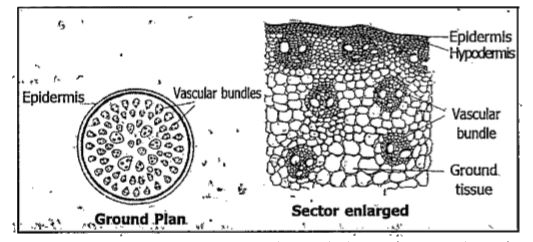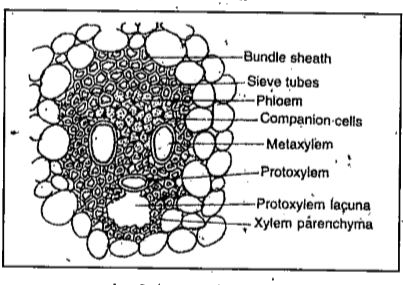Describe the T.S of a Monocot stem . Solution in Telugu
Internal structure of Monocot Stem : The anatomy of Monocot stem shows, four distinct parts - Epidermiş hypodermis, ground tissue, vascular bundles. A distinct cortexis absent. Endodermis, pericycle, medulla, medullary rays are absent."
I. Epidermis :
1) The outermost.layer is called epidermis. It is made up of living, rectangularor tabular cells. They are arranged compactly without intercellular spaces.
2) A waxy. layer is deposited on the outer surface of epidermis. This is called cuticle.
3) Trichomes are absent. Numerous stomata are found in the epidermis.
4) Epidermis gives protection to inner tissues. Stomata help inexchange of gases. Cuticle prevents evaporation of water.

II. Hypodermis: It is present beneath the epidermis. It is made up of 1 - 4 rows of thick walled sclerenchymatous fibres. Intercellular spaces are absent. It gives mechanical strength pay to the stem.
III. Ground Tissue :
1) Tissue next to the hypodermis filling the remaining part of the stem (except vascular bundles) is called ground tissue.
2) It is.parenchymatous.
3) Cells are thin walled with or without chloroplasts. They are loosely packed with intercellulär spaces.
4) It is .mainly concerned with synthesis and storage of a food materials.
IV. Vascular Bundles :
1) Numerous bundles are irregularly scattered in the ground tissue. Such an arrangement is called Atactostele.
2) Inner bundles are bigger. Peripheral bundles are small in size. They are oval in shape,
3) Each vascular bundle is enclosed by a sclerenchymatous sheath. So it is called fibro vascular bundle.
4) Each bundle has phloem towards outside and xylem towards inside of the bundle on the same radius. So it is - described as conjoint and collateral.
5) Vascular bundles are concerned with conduction of water, salts and food materials.
6) Cambium is absent between xylem and phloem. So the vascular bundle is closed type

7) Xylem is endarch (protoxylem towards centre). Xylem consists of fracheids, vessels, fibres and xylem parenchyma.
8). Xylem is arranged in the shape of .Y.. Out of four xylem vessels, two are metaxylem and two are protoxylem vessels.
One or two protoxyleí vessels are. crushed forming sigenous cavity. It is called protoxylem lacuna. It stores water.
10) Phloem has sieve tubes and companion cells. Phloem parenchyma is absent:
Topper's Solved these Questions
Similar Questions
Give a brief account of Dinoflagellates.
View SolutionDescribe the life cycle of Plasmodium vivax in mosquito.
View SolutionExplain different types of Racemos inflorescences.
View SolutionDescribe the vascular bundles of monocot stem.
View SolutionDescribe the internal structure of a monocot stem.
View SolutionCompare T.S. of monocot and dicot stem with the help of well labelled diagrams only.
View SolutionDescribe internal structure of monocot stem.
View SolutionDescribe the T.S. of dicot stem.
View SolutionWith the help of a neat labelled diagram, describe the T.S. of a monocot root.
View SolutionWith the help of a neat labelled diagram, describe T.S. of dicot stem (sunflower).
View SolutionDraw and label a part of T.S. of a monocot stem. Explain various tissues present in it.
View SolutionDescribe the T.S of a dicot stem .
View SolutionDescribe the T.S of a Monocot stem .
View SolutionDescribe the anatomy of monocot stem.
View SolutionDraw T.S. of monocot root.
View SolutionDraw a well labelled diagram of T.S of dicot and monocot stem.
View Solution
